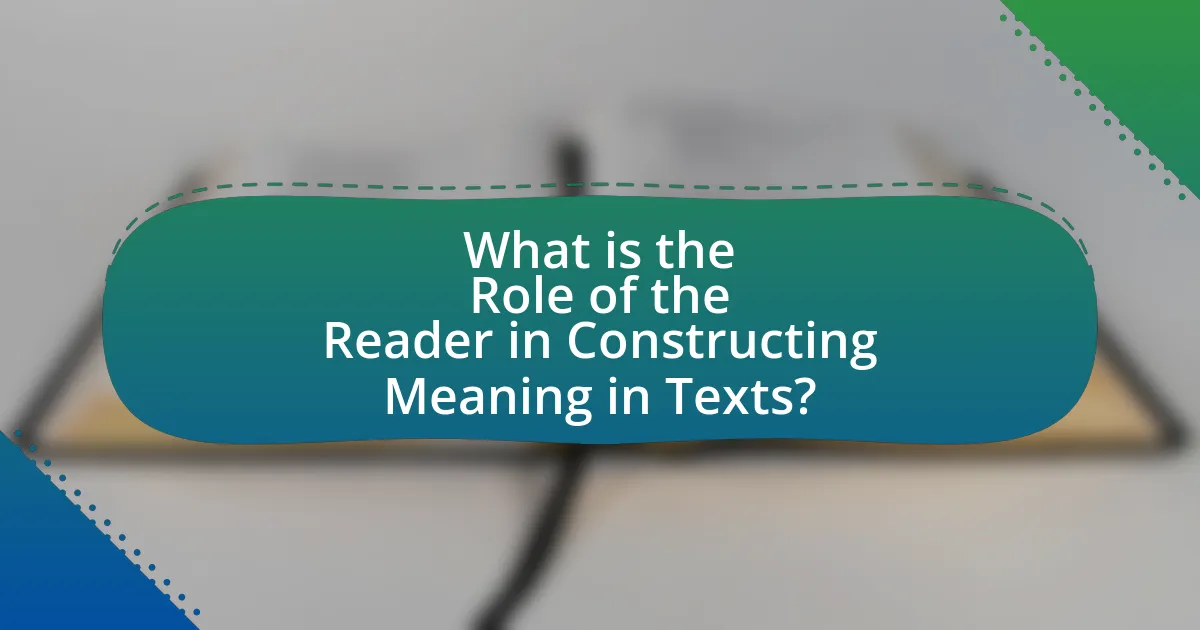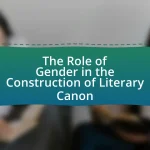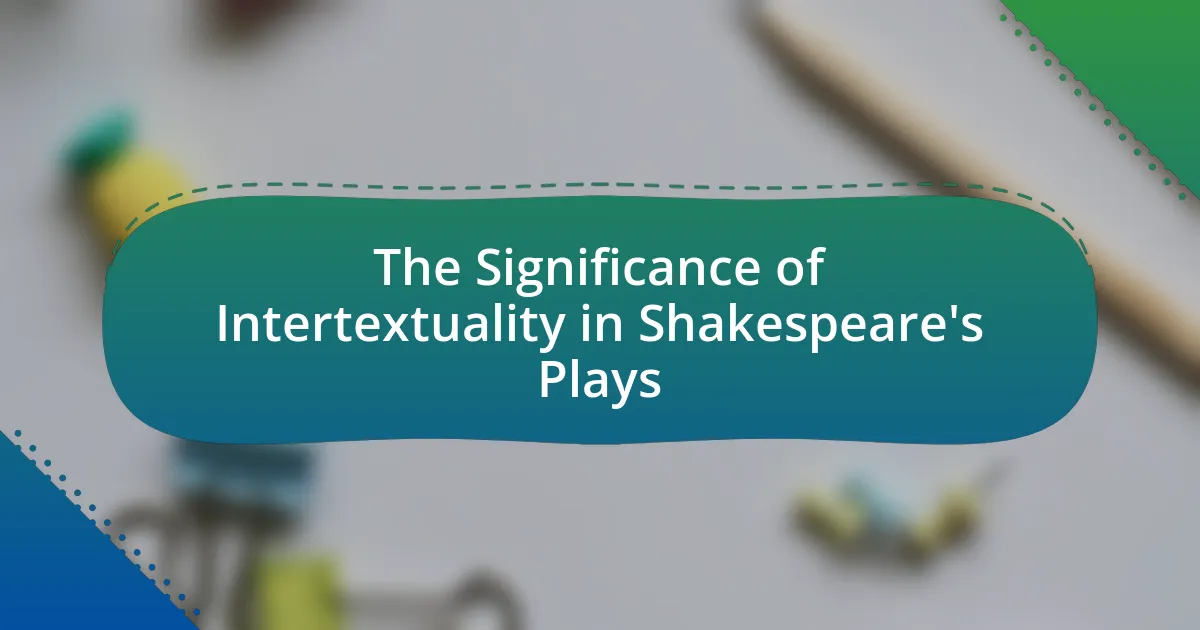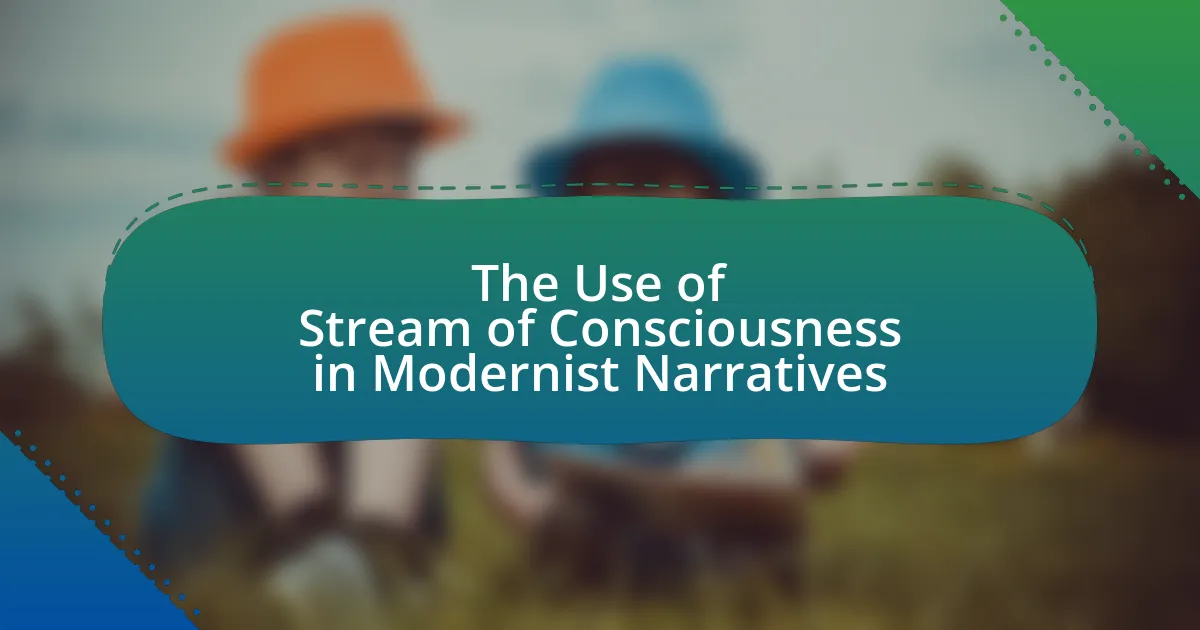The article examines the critical role of the reader in constructing meaning from texts, emphasizing that meaning is co-created through the interaction between the reader and the text. It explores how personal experiences, cultural context, and cognitive processes influence interpretation and comprehension. Key factors such as prior knowledge, emotional responses, and text features are discussed, highlighting their impact on how readers engage with and derive meaning from literary works. Additionally, the article outlines effective strategies for enhancing reading practices and comprehension, underscoring the importance of active engagement and discussion in the meaning-making process.

What is the Role of the Reader in Constructing Meaning in Texts?
The role of the reader in constructing meaning in texts is to actively engage with the content, interpreting and deriving significance based on personal experiences, knowledge, and context. Readers bring their own perspectives, which influence how they understand themes, characters, and messages within a text. Research by Rosenblatt (1978) in “The Reader, the Text, the Poem” emphasizes that meaning is co-created through the interaction between the reader and the text, highlighting that different readers can extract varied interpretations from the same material based on their unique backgrounds and cognitive processes. This interaction underscores the importance of reader agency in the meaning-making process.
How do readers interpret texts to create meaning?
Readers interpret texts to create meaning through a combination of personal experiences, cultural context, and textual analysis. This process involves actively engaging with the text, where readers draw on their background knowledge and emotional responses to understand the author’s intent and the themes presented. Research by Rosenblatt (1978) in “The Reader, the Text, the Poem” emphasizes that meaning is co-constructed between the reader and the text, highlighting the significance of individual interpretation. Additionally, studies show that readers utilize cognitive strategies, such as making inferences and visualizing scenarios, to enhance comprehension and derive personal significance from the material.
What cognitive processes are involved in reading comprehension?
Reading comprehension involves several cognitive processes, including decoding, vocabulary knowledge, inference making, and monitoring comprehension. Decoding allows readers to translate written symbols into sounds and words, which is essential for understanding text. Vocabulary knowledge enables readers to grasp the meanings of words, facilitating deeper comprehension. Inference making involves drawing conclusions and connecting ideas that are not explicitly stated in the text, enhancing overall understanding. Monitoring comprehension refers to the ability of readers to assess their understanding as they read, allowing them to adjust their strategies if they encounter difficulties. These processes work together to enable effective reading comprehension, as supported by research indicating that skilled readers utilize these cognitive strategies to construct meaning from texts.
How does prior knowledge influence interpretation?
Prior knowledge significantly influences interpretation by shaping how individuals understand and make sense of new information. When readers encounter a text, their existing knowledge, experiences, and beliefs act as a framework through which they filter and interpret the content. Research by Anderson and Pearson (1984) highlights that prior knowledge enhances comprehension by allowing readers to make connections between new information and what they already know, facilitating deeper understanding. This cognitive process is evident in studies showing that individuals with relevant background knowledge are better at recalling and integrating information from texts, demonstrating that prior knowledge is crucial in constructing meaning.
Why is the reader’s perspective crucial in meaning-making?
The reader’s perspective is crucial in meaning-making because it shapes the interpretation and understanding of a text. Each reader brings unique experiences, beliefs, and emotions that influence how they perceive and derive meaning from the content. Research by Rosenblatt (1978) in “The Reader, the Text, the Poem” emphasizes that meaning is not solely embedded in the text but is co-created through the interaction between the reader and the text. This interaction highlights the subjective nature of reading, where different readers can extract varied meanings from the same text based on their individual contexts.
How do personal experiences shape understanding of texts?
Personal experiences significantly shape understanding of texts by influencing interpretation and emotional response. Readers draw upon their own life events, cultural background, and personal beliefs to make sense of the narrative, characters, and themes presented in the text. For instance, a study by Rosenblatt (1978) in “The Reader, the Text, the Poem” emphasizes that meaning is co-constructed between the reader and the text, highlighting how individual experiences lead to varied interpretations. This interaction allows readers to connect personally with the material, making the reading experience unique and subjective.
What role does cultural context play in interpretation?
Cultural context significantly influences interpretation by shaping the meanings that readers derive from texts. This influence occurs because cultural norms, values, and experiences inform how individuals understand language, symbols, and narratives. For instance, a study by E. D. Hirsch in “Validity in Interpretation” highlights that readers’ backgrounds can lead to varying interpretations of the same text, as cultural references may resonate differently across diverse groups. Thus, cultural context acts as a lens through which readers construct meaning, affecting their engagement with and understanding of literary works.
What factors influence a reader’s construction of meaning?
A reader’s construction of meaning is influenced by several factors, including prior knowledge, cultural background, context, and emotional state. Prior knowledge allows readers to connect new information with existing mental frameworks, enhancing comprehension. Cultural background shapes interpretations and influences how readers relate to themes and characters in a text. Context, such as the setting and purpose of reading, provides additional layers of meaning, while a reader’s emotional state can affect engagement and interpretation. Research by Kintsch (1998) in “Comprehension: A Paradigm for Cognition” supports these claims, demonstrating that comprehension is a dynamic process shaped by these interrelated factors.
How do text features affect reader interpretation?
Text features significantly influence reader interpretation by guiding attention and shaping understanding. For instance, headings, bullet points, and images can highlight key concepts and organize information, making it easier for readers to grasp the main ideas. Research by McNamara et al. (2014) in “The Role of Text Features in Reading Comprehension” indicates that effective use of text features enhances comprehension and retention by providing visual cues that aid in the construction of meaning. Thus, the strategic implementation of text features directly impacts how readers engage with and interpret the content.
What impact do genre and structure have on meaning construction?
Genre and structure significantly influence meaning construction by shaping how readers interpret texts. Different genres, such as poetry, fiction, or academic writing, establish specific conventions and expectations that guide readers’ understanding. For instance, a narrative structure with a clear beginning, middle, and end helps readers follow the plot and derive meaning from character development and conflict resolution. Conversely, a non-linear structure may challenge readers to piece together meaning from fragmented information, requiring active engagement and interpretation. Research by M. A. K. Halliday in “Language as Social Semiotic” emphasizes that genre and structure serve as frameworks that facilitate or complicate the reader’s ability to construct meaning, demonstrating their critical role in the reading process.
How do linguistic choices influence reader engagement?
Linguistic choices significantly influence reader engagement by shaping the clarity, tone, and emotional resonance of the text. For instance, the use of vivid imagery and descriptive language can create a more immersive experience, prompting readers to visualize scenes and connect emotionally with characters. Research by Miall and Dobson (2001) in “Transitional Readers: The Role of Language in Reader Engagement” demonstrates that texts employing varied sentence structures and rich vocabulary enhance cognitive involvement, leading to deeper engagement. Additionally, the choice of colloquial versus formal language can affect relatability; informal language often fosters a sense of intimacy, making readers feel more connected to the narrative. Thus, linguistic choices directly impact how engaged readers feel with the text, influencing their overall experience and interpretation.
What psychological factors contribute to meaning-making?
Psychological factors that contribute to meaning-making include cognitive processes, emotional responses, and social influences. Cognitive processes such as attention, memory, and interpretation allow individuals to analyze and synthesize information from texts, facilitating personal connections to the material. Emotional responses, including empathy and personal relevance, enhance engagement and retention of information, making it more meaningful. Social influences, such as cultural background and shared experiences, shape how individuals interpret texts, leading to diverse meanings. Research by Bruner (1990) emphasizes that meaning is constructed through the interplay of these psychological factors, highlighting their critical role in the reader’s experience.
How does motivation affect a reader’s engagement with a text?
Motivation significantly enhances a reader’s engagement with a text by influencing their interest and willingness to invest cognitive resources. When readers are motivated, they are more likely to focus on the material, leading to deeper comprehension and retention of information. Research indicates that intrinsic motivation, such as personal interest in a subject, correlates with higher levels of engagement and understanding (Deci & Ryan, 2000). Conversely, low motivation can result in superficial reading and diminished interaction with the text, ultimately hindering the construction of meaning. Thus, motivation serves as a critical factor in determining the depth of a reader’s engagement and their ability to derive meaning from the text.
What role does emotional response play in interpretation?
Emotional response significantly influences interpretation by shaping how individuals perceive and understand texts. When readers encounter a narrative, their emotional reactions can activate personal memories and associations, which in turn affect their comprehension and meaning-making processes. Research indicates that emotions can enhance memory retention and engagement, leading to a deeper connection with the material. For instance, studies have shown that emotionally charged content is more likely to be remembered and can alter the reader’s perspective, thereby impacting their overall interpretation of the text.
How can understanding the reader’s role enhance reading practices?
Understanding the reader’s role enhances reading practices by enabling readers to actively engage with texts, leading to deeper comprehension and retention. When readers recognize their role in interpreting and constructing meaning, they become more aware of their personal biases, experiences, and expectations, which influence their understanding of the material. Research indicates that active engagement strategies, such as questioning and predicting, significantly improve comprehension outcomes (Duke & Pearson, 2002). By acknowledging their role, readers can adapt their strategies to better align with the text’s purpose and structure, ultimately fostering a more meaningful reading experience.
What strategies can readers use to improve comprehension?
Readers can improve comprehension by employing active reading strategies such as summarizing, questioning, and making connections. Summarizing involves distilling the main ideas of a text into concise statements, which enhances retention and understanding. Questioning encourages readers to engage with the material by asking clarifying questions, fostering deeper analysis. Making connections, whether to prior knowledge or other texts, helps situate new information within a broader context, facilitating better integration of concepts. Research indicates that these strategies significantly enhance comprehension skills, as evidenced by studies showing improved test scores among students who actively engage with texts through these methods.
How can active reading techniques facilitate meaning construction?
Active reading techniques facilitate meaning construction by engaging readers in a dynamic interaction with the text, enhancing comprehension and retention. Techniques such as annotating, summarizing, and questioning encourage readers to actively process information, allowing them to connect new ideas with prior knowledge. Research indicates that these strategies lead to deeper understanding; for instance, a study by Pressley and Afflerbach (1995) found that students who employed active reading strategies demonstrated significantly improved reading comprehension compared to those who did not. This evidence supports the assertion that active reading techniques are essential for effective meaning construction in texts.
What are effective ways to reflect on personal interpretations?
Effective ways to reflect on personal interpretations include journaling, discussing interpretations with others, and engaging in critical reading practices. Journaling allows individuals to articulate their thoughts and feelings about a text, fostering deeper understanding and self-awareness. Discussing interpretations with peers or mentors can provide new perspectives and challenge existing viewpoints, enhancing the interpretive process. Engaging in critical reading practices, such as annotating texts or asking probing questions, encourages readers to analyze their responses and the text’s meaning more thoroughly. These methods are supported by educational research, which indicates that reflective practices improve comprehension and critical thinking skills in readers.
How can educators support students in constructing meaning?
Educators can support students in constructing meaning by implementing strategies that promote active engagement with texts. These strategies include encouraging discussions that allow students to express their interpretations, facilitating collaborative learning experiences where students can share perspectives, and providing scaffolding techniques that guide students through complex texts. Research indicates that when educators use methods such as reciprocal teaching, which involves summarizing, questioning, clarifying, and predicting, students demonstrate improved comprehension and meaning-making abilities. This approach is supported by studies showing that active participation in learning processes enhances students’ ability to construct meaning from texts effectively.
What instructional methods promote reader engagement and interpretation?
Instructional methods that promote reader engagement and interpretation include interactive reading strategies, such as think-alouds, reciprocal teaching, and guided reading. These methods actively involve readers in the text, encouraging them to articulate their thoughts and predictions, which enhances comprehension and critical thinking. Research by Palincsar and Brown (1984) on reciprocal teaching demonstrates that this method significantly improves students’ ability to summarize, question, clarify, and predict, leading to deeper engagement with the material. Additionally, using graphic organizers helps readers visualize relationships within the text, further aiding interpretation and retention.
How can discussions enhance understanding of texts?
Discussions enhance understanding of texts by facilitating the exchange of diverse perspectives and interpretations among participants. This collaborative dialogue allows readers to articulate their thoughts, challenge assumptions, and clarify ambiguities in the text. Research indicates that engaging in discussions can lead to deeper comprehension, as it encourages critical thinking and the synthesis of ideas. For instance, a study by Mercer and Sams (2006) found that students who participated in structured discussions demonstrated improved analytical skills and a greater ability to connect concepts within the text. Thus, discussions serve as a vital tool in the reader’s process of constructing meaning from texts.
What are best practices for fostering meaning-making in reading?
Best practices for fostering meaning-making in reading include encouraging active engagement, promoting discussion, and integrating diverse texts. Active engagement can be achieved through strategies such as questioning, predicting, and summarizing, which help readers connect personally with the material. Promoting discussion allows readers to articulate their thoughts and interpretations, enhancing comprehension and critical thinking. Integrating diverse texts exposes readers to various perspectives and contexts, enriching their understanding and enabling them to draw connections between different ideas. Research indicates that these practices significantly improve comprehension and retention, as evidenced by studies showing that students who engage in discussions about texts demonstrate higher levels of understanding and analytical skills.




